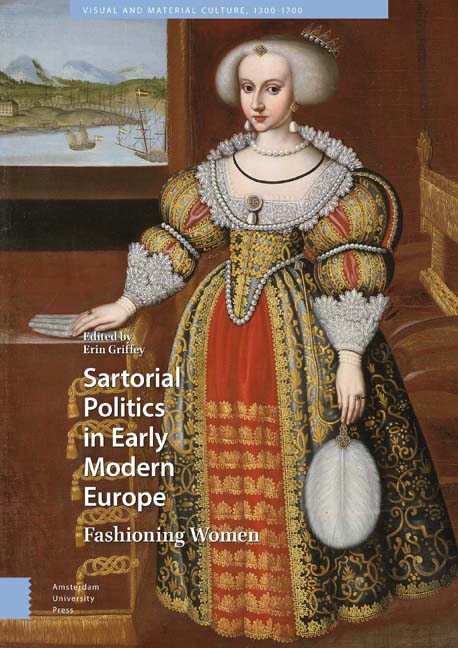Book contents
- Frontmatter
- Acknowledgements
- Contents
- List of Illustrations
- Introduction
- 1 Isabella d’Este's Sartorial Politics
- 2 Dressing the Queen at the French Renaissance Court: Sartorial Politics
- 3 Dressing the Bride: Weddings and Fashion Practices at German Princely Courts in the Fifteenth and Sixteenth Centuries
- 4 Lustrous Virtue: Eleanor of Austria's Jewels and Gems as Composite Cultural Identity and Affective Maternal Agency
- 5 Queen Elizabeth: Studded with Costly Jewels
- 6 A ‘Cipher of A and C set on the one Syde with diamonds’: Anna of Denmark's Jewellery and the Politics of Dynastic Display
- 7 ‘She bears a duke's revenues on her back’: Fashioning Shakespeare's Women at Court
- 8 How to Dress a Female King: Manifestations of Gender and Power in the Wardrobe of Christina of Sweden
- 9 Clothes Make the Queen: Mariana of Austria's Style of Dress, from Archduchess to Queen Consort (1634–1665)
- 10 ‘The best of Queens, the most obedient wife’: Fashioning a Place for Catherine of Braganza as Consort to Charles II
- 11 Chintz, China, and Chocolate: The Politics of Fashion at Charles II's Court
- 12 Henrietta Maria and the Politics of Widows’ Dress at the Stuart Court
- Works Cited
- Index
1 - Isabella d’Este's Sartorial Politics
Published online by Cambridge University Press: 21 November 2020
- Frontmatter
- Acknowledgements
- Contents
- List of Illustrations
- Introduction
- 1 Isabella d’Este's Sartorial Politics
- 2 Dressing the Queen at the French Renaissance Court: Sartorial Politics
- 3 Dressing the Bride: Weddings and Fashion Practices at German Princely Courts in the Fifteenth and Sixteenth Centuries
- 4 Lustrous Virtue: Eleanor of Austria's Jewels and Gems as Composite Cultural Identity and Affective Maternal Agency
- 5 Queen Elizabeth: Studded with Costly Jewels
- 6 A ‘Cipher of A and C set on the one Syde with diamonds’: Anna of Denmark's Jewellery and the Politics of Dynastic Display
- 7 ‘She bears a duke's revenues on her back’: Fashioning Shakespeare's Women at Court
- 8 How to Dress a Female King: Manifestations of Gender and Power in the Wardrobe of Christina of Sweden
- 9 Clothes Make the Queen: Mariana of Austria's Style of Dress, from Archduchess to Queen Consort (1634–1665)
- 10 ‘The best of Queens, the most obedient wife’: Fashioning a Place for Catherine of Braganza as Consort to Charles II
- 11 Chintz, China, and Chocolate: The Politics of Fashion at Charles II's Court
- 12 Henrietta Maria and the Politics of Widows’ Dress at the Stuart Court
- Works Cited
- Index
Summary
Abstract
For Isabella d’Este (1474–1539), the sartorial was deeply political. Although her state of Mantua was a second-league power, fashion played a key role in shrewd strategies of diplomacy, networking, and co-rule with her husband Francesco II Gonzaga, and magnified the city's influence. With a dazzling retinue, Isabella dressed for political success whatever the occasion: on travels, for wedding festivities, or in mourning. Not only could Isabella suggest expedient allegiance during the turbulent Italian Wars by wearing fleurs-de-lys or Spanish blouses, but she could use her reputation for sophistication and trendsetting as leverage with powerful states, winning favour and service from those above and below her. It is not without merit that Isabella has been dubbed ‘Machiavelli in skirts’.
Key words: zazara headdress; Renaissance power sharing; Renaissance female court networks; ladies-in-waiting; Renaissance cosmetics
[siamo] tutta vestita de ziglij
We are dressed all in fleurs-de-lys
‒ Isabella d’Este, 1499In October 1499, Isabella d’Este, marchesa of Mantua (1474–1539), wrote her envoy in Venice a letter that she intended to be shown to the French ambassador, Accurse Mainier. The ambassador was making veiled threats of a visit to Mantua and had sent apologies to Isabella, with a menacing undertone, for having questioned the marchesa's commitment to Mantua's alliance with France. Should the ambassador visit her, Isabella reassured Mainier, he would find her dressed all in lilies, her clothing adorned with French fleurs-de-lys. The symbolism of Isabella's attire, asserting her credibility as ‘a good francese’, and dedicated ally of Louis XII, was politically powerful in dangerous times. October 1499 found Isabella and her husband Marchese Francesco II Gonzaga (1466–1519) in a thorny predicament. Five years into the Italian Wars (1494–1559), with the peninsula a battleground for supremacy between French and imperial powers and with ever-shifting alliances and tussles for advancement – indeed, for survival – by the states of Italy, Mantua was the kind of second-league principality ripe for swallowing up. It was eyed greedily by foreign sovereigns and by state-snatching chancers, such as the pope's son Cesare Borgia, with the backing of an ultramontane army. On 6 October, the king of France had entered Milan and ejected the city's duke Lodovico Sforza, husband of Isabella's late sister Beatrice d’Este, and at the king's side were the rapacious Cesare Borgia and Isabella's husband Francesco Gonzaga, in his capacity as military captain.
- Type
- Chapter
- Information
- Sartorial Politics in Early Modern EuropeFashioning Women, pp. 33 - 56Publisher: Amsterdam University PressPrint publication year: 2019

